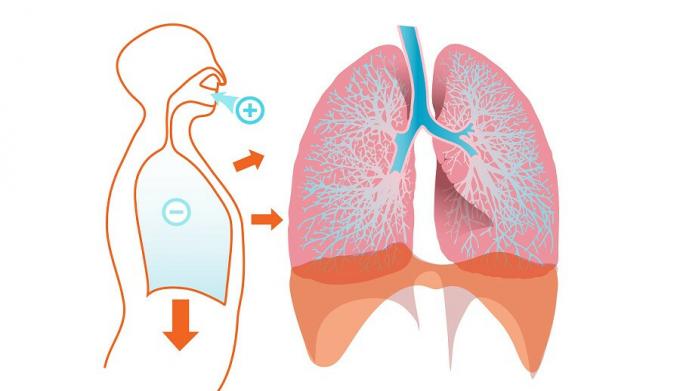Respiratory system: characteristics, parts, functions and diseases
The respiratory apparatus or system refers to the set of organs that living beings have in order to exchange gases with the environment. This cold definition is soon postulated, but the concept is put more into perspective when we consider that oxygen is the engine of cellular work, with all that that entails.
Mitochondria (cell organelles) convert glucose and oxygen into high-energy bonds that can be stored in ATP and used by the cell for metabolism. Thus, we can say without fear that, together with water, the air in the environment makes life as we know it possible.
That is why to encompass the mammoth world of the respiratory system we require a multidisciplinary approach: it is not enough for us to focus on its morphology, but we must also explore what happens when it fails and the numerical data that support its importance. If you want to get a general idea about this exciting physiological conglomerate, read on.
- Related article: "The 12 systems of the human body (and how they work)"
Respiratory system: its main characteristics
According to the Royal Spanish Academy of the language, the term "system" in its most biological meaning is defined as a set of organs that intervene in some of the main vegetative functions of beings alive. In this case there is no doubt that we are facing the breathing phenomenon, which is said soon.
To begin to dissect this web of biological networks and mechanisms, we can focus on the parts of this apparatus. Let's go there.
Parts of the respiratory system
It is necessary to clarify that the respiratory system is composed of three different parts.
First of all, we have an air-conducting portion (nasal cavities, bronchi, bronchioles... etc), or what is the same, a series of branched tubules through which gases circulate.
Beyond this, a respiratory portion can also be distinguished for gas exchange, where it enters the most "blood" component of the system is at stake (for example, the alveoli and their capillaries). Finally, to close this triad, living beings present a ventilatory mechanism, which "Pumps" the entry and exit of gases from our body (rib cage and intercostal muscles, for example).
We are facing a system of complex evolutionary origin that imitates exquisitely sophisticated machinery (or rather the other way around, since every machine is based on physical and biological processes).
This apparatus features a series of highways and travel channels (conductive portion), a material exchange center (alveoli and parts associated circulatory systems) and a pumping device that exerts the pressures necessary for the “machine” to function (the muscles, rib cage and diaphragm). All these elements are perfectly matched to maximize the individual's energy output at any given time.
Yes, we could present you with a list of all the organs and structures associated with this apparatus: nostrils, larynx, pharynx, trachea, lungs, diaphragm... etc, but we would be missing a lot of relevant information that maybe not know. Let's remember: to understand a system, even in a general way, we should not limit ourselves only to their physiological structures. So let's jump into the world of breathing.
- You may be interested in: "The 7 parts of the lung: functions and characteristics"

Breathing and its figures
"Respiration" is called the process by which living beings exchange gases with the external environment. What not many people know is that this term has another meaning, since respiration is also considered to be the set of reactions biochemicals by which some organic compounds are completely degraded, by oxidation, until they become substances inorganic. As you may have guessed, this is cellular respiration, or what is the same, the process of obtaining energy.
We are going to focus on the first definition of the term: pulmonary respiration (in vertebrates, since other animals breathe through tracheas or gills). As a general concept, we can affirm that the process of inspiration and expiration is about a pressure game. Intrapleural pressure, intrathoracic volume, associated musculature and diaphragm vary in position and functionality so that this mechanical activity can be performed without problems. How does this translate into objective figures?
- Humans breathe in and out between five and six liters of air per minute.
- In 24 hours a healthy person inhales and exhales about 8000 liters of air.
- In breaths as such, this translates to about 21,000 a day.
- Through this exchange, each human contributes a little more than a kilo in weight of CO2 to the atmosphere on a daily basis.
This data puts things in perspective, right? Due to the functionality of the respiratory system, the oxygen content in the body of any living being is higher in the organs involved in this process, but decreases throughout any arterial and venous system. This oxygen content is quantified with the partial pressure, that is, the theoretical pressure of the gas if it occupied the entire volume of the original mixture. The alveolar pressure of the pulmonary gases is 14.2 Kpa (Kilopascals).
All these facts and figures are of great interest, but all that glitters is not gold. Such a complex system requires an exquisite integration of all its components, and unfortunately, this is not always the case.
- You may be interested in: "Glottis: functions and characteristics of this part of the body"
Diseases of the respiratory system
We have talked about the parts of this apparatus and the respiratory process, but we cannot leave ourselves in the inkwell what happens when it fails. The World Health Organization gives us the following data:
- About 235 million people (7% of adults) suffer from one of the most common respiratory disorders: asthma.
- In 2016 more than 400,000 people died from asthma. In the past, it was estimated that 80% of deaths occur in low-income countries.
- Chronic Obstructive Pulmonary Disease (COPD) affects more than 200 million people in the world.
- This last data is even worse if one takes into account that various studies affirm that up to 90% of cases are undiagnosed.
- Pneumonia is responsible for 15% of deaths in children under five years of age.
We could continue to expose data of this nature for years. Respiratory diseases can be caused by bacteria, viruses, helminth parasites, allergies, dysfunctions in the immune system, cancer, hereditary diseases and many other causes. Basically anything that can enter the upper or lower airways can lead to pathology.
The apparent vulnerability of the respiratory system reaches such an extent that fungi can grow inside the lungs. This is the case of bronchopulmonary aspergillosis and invasive pulmonary aspergillosis, pathologies caused by the fungus of the genus Aspergillus.
Such is the lethality of this disease that, if it spreads through the patient's organs, the mortality rate can reach more than 87%. For the relief of readers, this condition only occurs in people who are immunosuppressed or with severe respiratory conditions.
Another of the queens of respiratory tract pathologies is, without a doubt, lung cancer. In Spain about 18,000 people die annually from this malignant tumor process, which corresponds to 27% of all deaths from cancer. Smoking is associated with up to 90% of deaths from lung cancer, so the recommendations are made on their own.
Resume
As we have seen, the respiratory system gives us one of lime and another of sand. On the one hand it is an exciting apparatus that integrates the functions of various organs and structures exactly, but on the other, its malfunction and disorders can end the life of the patient, depending on their immune situation, place of origin and lifestyle.
Once again, we do not move only in a physiological field, because beyond the tissues and structures that give shape and name to a system, there is a series of exciting numerical data that is often overlooked when addressing issues of this nature as concrete.
Bibliographic references:
- Respiratory system, student resources of the University of Alcalá de Henares (UAH). Picked up on September 25 in https://portal.uah.es/portal/page/portal/epd2_asignaturas/asig650019/informacion_academica/Respiratorio.pdf
- Lung cancer, AECC. Picked up on September 25 in https://www.aecc.es/es/todo-sobre-cancer/tipos-cancer/cancer-pulmon/evolucion-cancer-pulmon#:~:text=Mortalidad%20del%20c%C3%A1ncer%20de%20pulm%C3%B3n,%25%20del%20total%20de%20muertes).
- How the Lungs Work, National Heart, Lung, and Blood Institute (NIH). Picked up on September 25 in https://www.nhlbi.nih.gov/health-topics/espanol/como-funcionan-los-pulmones#:~:text=Los%20pulmones%20hacen%20ingresar%20el%20ox%C3%ADgeno%20a%20la%20sangre%20y, to% 20make% 20possible% 20la% 20breathing% C3% B3n.
- Chronic Respiratory Diseases, World Health Organization (WHO). Picked up on September 25 in https://www.who.int/respiratory/es/
- Pérez-Arellano, J. L., Andrade, M. A., López-Abán, J., Carranza, C., & Muro, A. (2006). Helminths and respiratory system. Archives of Bronconeumology, 42 (2), 81-91.
- The global impact of respiratory diseases, World Health Organization (WHO). Picked up on September 25 in https://www.who.int/gard/publications/The_Global_Impact_of_Respiratory_Disease_ES.pdf



